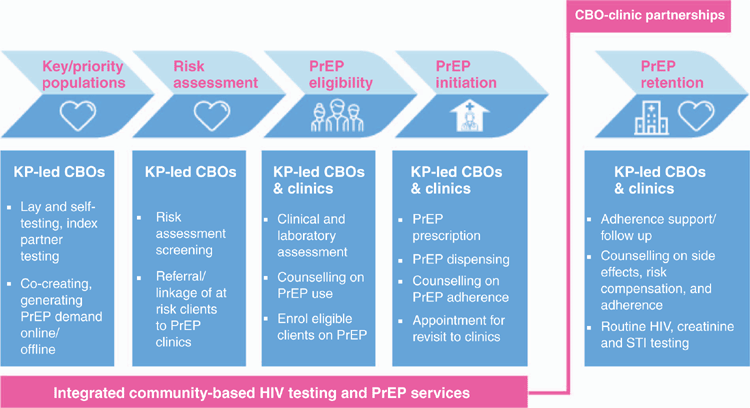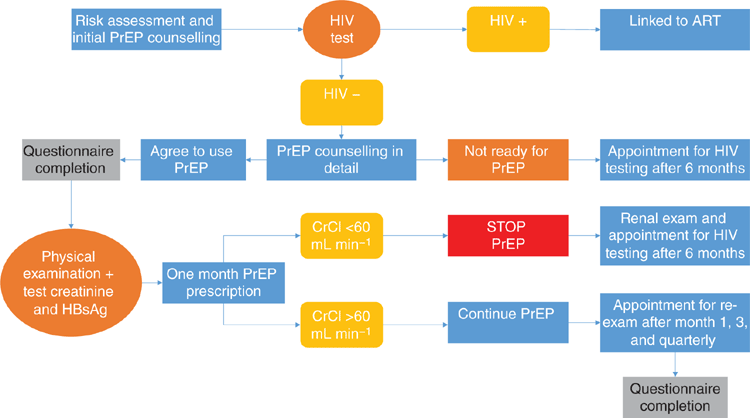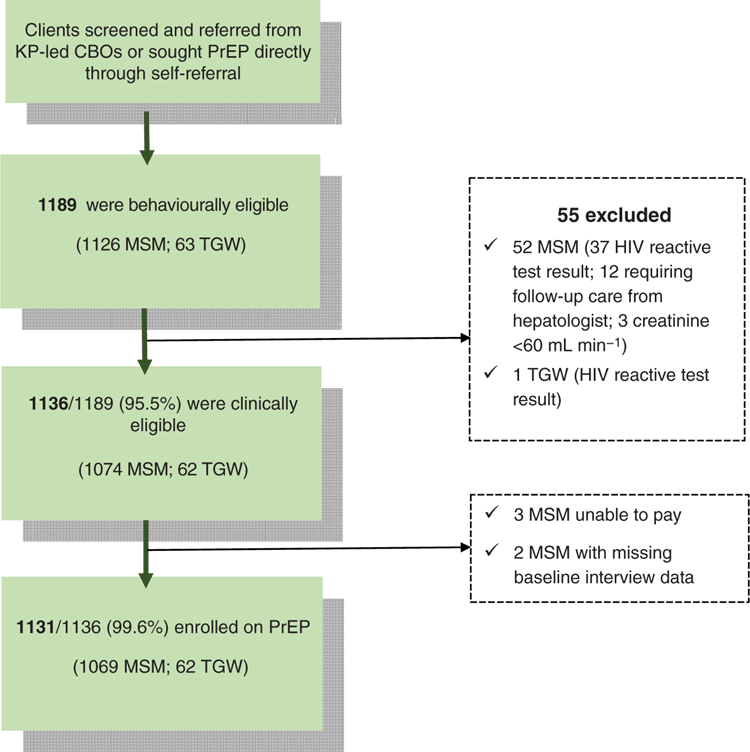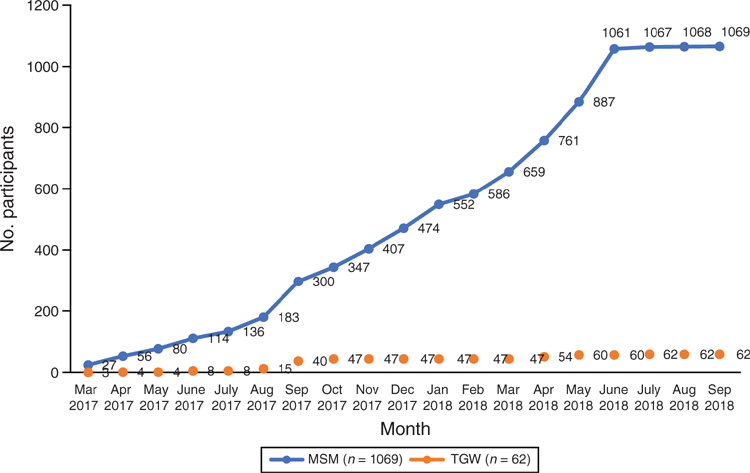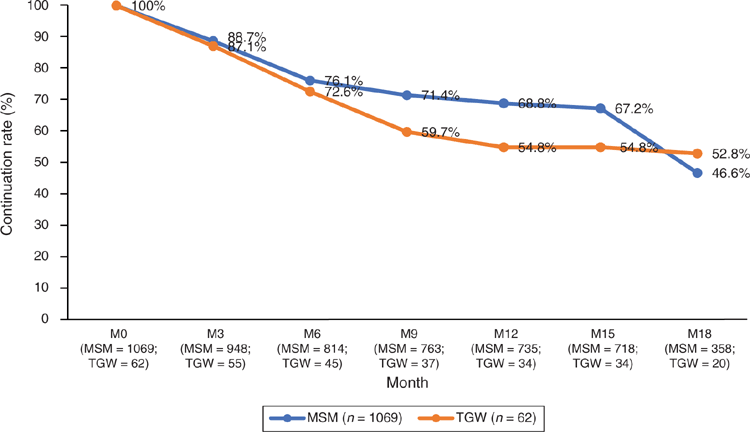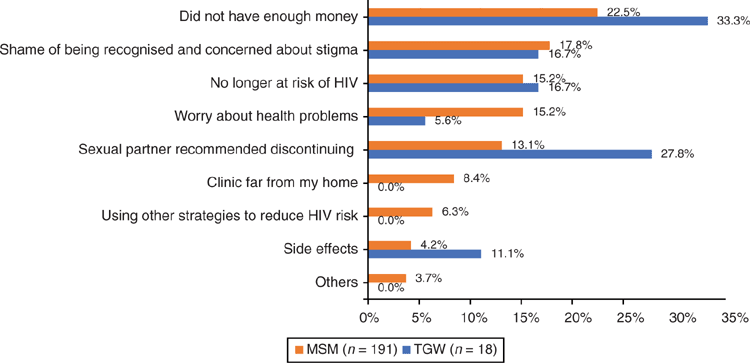Prepped for PrEP? Acceptability, continuation and adherence among men who have sex with men and transgender women enrolled as part of Vietnam’s first pre-exposure prophylaxis program
Kimberly Elizabeth Green A J , Long Hoang Nguyen B , Huong Thu Thi Phan B , Bao Ngoc Vu A , Minh Hung Tran C , Huu Van Ngo A , Van Thi Thu Tieu D , Hung Van D , Thanh Minh Le E , Khang Quang Do F , Phong Anh Nguyen G , Trang Minh Ngo H , Anh Hong Doan A , Diep Thi Ngoc Bui C , Trang Nguyen Nhu Nguyen I , Lan Thi Xuan Hang I , Tham Thi Tran A and Binh Quoc Luong D
A J , Long Hoang Nguyen B , Huong Thu Thi Phan B , Bao Ngoc Vu A , Minh Hung Tran C , Huu Van Ngo A , Van Thi Thu Tieu D , Hung Van D , Thanh Minh Le E , Khang Quang Do F , Phong Anh Nguyen G , Trang Minh Ngo H , Anh Hong Doan A , Diep Thi Ngoc Bui C , Trang Nguyen Nhu Nguyen I , Lan Thi Xuan Hang I , Tham Thi Tran A and Binh Quoc Luong D
A PATH, Level 11, Hanoi Towers, Hanoi, Vietnam.
B Ministry of Health/Vietnam Administration of HIV/AIDS Control, Hanoi, Vietnam.
C Center for Creative Initiatives in Health and Population, Hanoi, Vietnam.
D Ho Chi Minh City Center for Disease Control (former Provincial AIDS Center), Ho Chi Minh City, Vietnam.
E Glink Social Enterprise, Ho Chi Minh City, Vietnam.
F Galant Clinic, Ho Chi Minh City, Vietnam.
G My Home Clinic, Ho Chi Minh City, Vietnam.
H United States Agency for International Development, Hanoi, Vietnam.
I Life Center, Ho Chi Minh City, Vietnam.
J Corresponding author. Email: kgreen@path.org
Sexual Health 18(1) 104-115 https://doi.org/10.1071/SH20167
Submitted: 25 September 2020 Accepted: 23 December 2020 Published: 3 March 2021
Journal Compilation © CSIRO 2021 Open Access CC BY-NC-ND
Abstract
Background: HIV prevalence among men who have sex with men (MSM) and transgender women (TGW) in Vietnam is high, whereas coverage of effective HIV prevention services has been inadequate. Studies have measured MSM and TGW demand for pre-exposure prophylaxis (PrEP) services, which led to the design of the first ever PrEP program in Vietnam, Prepped for PrEP (P4P). Methods: In March 2017, PrEP services were offered in Ho Chi Minh City as part of the P4P demonstration project, enabling same-day enrolment in three key population (KP)-led clinics and four public clinics. P4P aimed to assess acceptability and feasibility of PrEP services through calculating the rate of PrEP enrolment over time, and quarterly measures of continuation and adherence over an 18-month period. Results: A total of 1069 MSM and 62 TGW were enrolled in P4P. Average monthly PrEP enrolment among MSM increased five-fold from the first 3 months (March–June 2017) to the last 3 months of active enrolment (March–June 2018), whereas for TGW, no increased trend in PrEP enrolment per quarter was seen. Self-reported PrEP adherence was >90% at all time points among MSM, but varied from 11.1% to 88.9% among TGW. PrEP continuation was calculated at months 3, 6, 9, 12, 15 and 18. For MSM, it was 88.7% at month 3, 68.8% at month 12 and 46.6% at month 18, whereas for TGW, it was 87.1%, 54.8% and 52.8%, respectively. Multivariable regression identified that MSM with lower-than-average income (adjusted odds ratio (aOR) 2.38 (95% confidence interval (CI): 1.59–3.54), P = 0.000), aged >30 years (aOR 2.03 (95% CI: 1.30–3.40), P = 0.007) and with an increasing number of sex partners (aOR: 1.06 (1.01–1.11), P = 0.011) had greater odds of remaining on PrEP. For TGW, being aged >30 years was associated with continuing on PrEP (aOR 5.62 (95% CI: 1.05–29.9), P = 0.043). Conclusions: We found PrEP to be highly acceptable among MSM and moderately acceptable among TGW. Continuation rates were relatively high for the first roll-out of PrEP; however, those aged ≤30 years were much more likely to discontinue services. Scaling-up PrEP through differentiated and community-led and engaged PrEP service delivery will be key to effectively increase access and uptake over the next 5 years.
Keywords: Asia, community-led health services, differentiated care, HIV prevention, key populations, key population-led health services, same-day pre-exposure prophylaxis, Vietnam, vulnerable populations.
Introduction
Oral HIV pre-exposure prophylaxis (PrEP) has been recommended as a critical prevention strategy among men who have sex with men (MSM), transgender women (TGW), and HIV serodiscordant couples since 2012, and for all populations at substantial risk of HIV since 2015.1,2 Where PrEP has been offered at scale alongside successful efforts to test and treat people living with HIV (PLHIV), year-on-year declines in new infections have been observed – as much as 50% in San Francisco over 5 consecutive years and 74% in Uganda and Kenya combined.3–5 However, roll-out has been slow in most lower- and middle-income Asia–Pacific countries (https://data.prepwatch.org/).
In Vietnam, HIV prevalence among MSM has been on the rise since 2011, increasing from 4% to 10.8% in 2018.6–12 Although there are no surveillance studies in place among TGW who have sex with men, one cross-sectional study in Ho Chi Minh City (HCMC) measured a HIV prevalence of 18% in 2016.13
Overall coverage of HIV prevention and testing efforts among MSM and TGW has been limited, in part due to funding constraints, but also because HIV services were relatively uniform and offered primarily in the public sector, with a relatively circumscribed role for MSM and TGW community-based organisations (CBOs). HIV prevention interventions among MSM and TGW were characterised as peer condom distribution and referrals for HIV testing.14 As a proxy of HIV service reach, annual HIV testing among MSM (there is no such data for TGW) measured through surveillance studies was 33% on average from 2011 to 2015.6–8
In late 2015, the Ministry of Health in Vietnam approved a pilot for a CBO-delivered HIV lay- and self-testing. In HCMC and Hanoi, these services significantly boosted uptake of HIV testing among those who had never tested before and were at risk of HIV exposure. The key population (KP)-led community testing intervention utilised online platforms such as Facebook and Grindr to access MSM and TGW who would otherwise not be reached by traditional communication efforts, thereby significantly expanding potential connection with those at risk of HIV. Community HIV testing elevated the role, profile, and growth of KP CBOs, a sub-set of which gained the expertise and resources to establish licenced private clinics in HCMC.15–17 The first, Glink clinic, was registered in 2016, followed by Galant and My Home clinics.
A handful of online and in-person studies were conducted to assess oral PrEP readiness among MSM and TGW in Vietnam.18–21 Three studies by Oldenburg et al.18–20 implemented in 2014 and 2015, found oral PrEP awareness to be limited among MSM and TGW, and perhaps as a result, measured modest interest in using oral PrEP. An assessment of PrEP acceptability, service preferences, and willingness to pay was conducted in late 2016 in HCMC and Hanoi among MSM and TGW. Using convenience sampling, 799 individuals (727 MSM and 72 TGW) opted to respond to the survey. Of those interviewed, 91% self-assessed as being at risk of HIV and 89% said they would opt for PrEP if available. Importantly, when asked about service preferences, 71% stated a preference for PrEP to be delivered by a KP organisation, whereas only 13% selected a preference for accessing PrEP through the public sector. In addition, 83.2% responded that they were willing to pay for PrEP and of those, 75.6% were willing to pay US$0.86 cents, whereas 63.7% were willing to pay US$1.30 per day for PrEP.21–23
In 2016, the Vietnam Administration for HIV/AIDS Control (VAAC), KP leaders, and PATH, through the US Agency for International Development (USAID)-funded Healthy Markets project, co-created Vietnam’s first PrEP program titled ‘Prepped for PrEP’ (P4P), which was launched in March 2017. The aim of P4P was to assess acceptability and feasibility of PrEP services among MSM, TGW, and HIV-negative partners of those newly HIV diagnosed, and to ultimately trigger larger adoption and scale-up of PrEP through the US President’s Emergency Plan for AIDS Relief (PEPFAR), Global Fund, and Vietnam public sector financing. This paper describes the intervention, methods, results, and implications of a rolling enrolment observational study that was embedded within the P4P program in HCMC, Vietnam from March 2017 to September 2018 to inform national scale-up of PrEP services.
Methods
The P4P service delivery model was defined through a process of consultation throughout 2016 with KP leaders and organisations, local clinics both private and public, and with the VAAC and HCMC Provincial AIDS Centre. Engagement to shape the PrEP service delivery model was both formal and informal and included a blended online and in-person survey among MSM and TGW to assess PrEP acceptability and service preferences (described above), as well as a study tour to Bangkok to learn from PrEP implementation through the PEPFAR/USAID- and LINKAGES-supported Thai Red Cross PrEP-30 (now PrEP-15) and Princess PrEP services. The study tour enabled the Vietnam delegation to better prepare for PrEP start-up and included representation from KP CBOs, public and private clinics, the HCMC provincial AIDS centre, the VAAC, and USAID. In February 2017, the VAAC approved implementation of P4P through which daily oral PrEP would be made available to up to 1200 MSM, TGW, and HIV-negative partners of those who were newly HIV diagnosed and enrolled on antiretroviral therapy (ART) in seven clinics in HCMC. These clinics included three that were KP-led private community clinics – Glink, Galant, and My Home – and four public out-patient clinics (OPCs) in Districts 1, 8, 11, and Thu Duc. The same month, staff from the seven clinics, nine KP CBOs, and the HCMC provincial AIDS centre, were trained in PrEP service delivery. The training included screening for PrEP eligibility, PrEP monitoring, and counselling for PrEP continuation. PrEP services through P4P launched in March 2017.24
P4P was designed as a partnership between KP-led CBOs, KP-led clinics, and public HIV OPCs. Figure 1 shows how KP CBOs and the public and private clinics work together to ensure optimal PrEP access and continuation. Given their extensive role in HIV prevention counselling and HIV lay-, self-, and index-testing, KP CBOs played a critical role in providing information about PrEP to clients that tested HIV negative, doing a pre-screen for eligibility and then referring them for PrEP services at one of the seven participating clinics. In addition, because most KP CBOs are heavily engaged online, they posted information on PrEP and where to go for PrEP services on their social media and websites. Individuals were then enrolled for same-day PrEP at one of the seven clinics and received support from KP CBOs to continue PrEP for as long as they remained at risk and opted for PrEP as their primary method for HIV prevention.
Given P4P was the very first PrEP service delivered in Vietnam, no public or large-scale donor financing was available. Therefore, a pragmatic fee-based approach was put in place based on data generated from the previously described December 2016 PrEP acceptability and willingness to pay survey, and experience from the Thai Red Cross’s PrEP-30 program.21,25 A small donation from Mylan allowed for the first month to be free so clients could try PrEP and then decide if they wanted to continue. Thereafter, the cost for PrEP was US$15 a month, which covered the price of Mylan’s India-manufactured and locally registered RICOVIR-EM (fixed-dose tenofovir disoproxil fumarate (TDF) 300 mg/emtricitabine (FTC) 200 mg – TDF/FTC). The costs for client consultation and follow up, and essential laboratory investigations (HIV, serum creatinine, and hepatitis B), were subsidised by the USAID/PATH Healthy Markets project.
Same-day client enrolment for PrEP was standardised across sites. Clients who sought PrEP services at one of the seven participating clinics were first assessed for HIV risk using the MSM Risk Index that comprised six questions with a minimum score of 0 and a maximum of 45.26 Risk factors included one of the following: having insertive and/or receptive condomless anal sex; having sex with someone known to be living with HIV but virally unsuppressed; having multiple sex partners; injecting drugs or using amphetamine-type substances in the past 6 months; or otherwise perceiving themselves at risk of HIV (see Fig. 2 for P4P service flow). Those who were eligible then received information on the monthly cost of PrEP, the service package, sexually transmissible infection (STI) prevention and condom use, and frequency of clinic visits for PrEP monitoring. After this, clients could then opt-in or opt-out of the service. For clients who opted out, HIV prevention counselling was offered based on the client need. For clients who opted in, individuals were screened for acute HIV infection (AHI) influenza-like symptoms and tested for HIV using the rapid fourth generation antigen/antibody test, Alere™ HIV Combo (Abbott Laboratories). Individuals found to have HIV were supported to seek a confirmation diagnosis and enrol for ART at the clinic of their choosing.
Clients who were HIV-negative and behaviourally eligible for PrEP were also tested for serum creatinine (Cr) levels and hepatitis surface antigen (HBsAg). Results for both tests were returned by the next day. Individuals who had an estimated glomerular filtration rate (eGFR) of <60 mL min−1 were advised to stop taking PrEP and to see a renal specialist. Those who were HBsAg reactive were referred to a hepatologist for further assessment so that those with chronic hepatitis B virus (HBV) could be managed by a specialist and receive dual benefit of TDF/FTC for HIV prevention and HBV management.
Clients were also counselled on the benefits of testing for syphilis, chlamydia, and gonorrhoea, as well as for hepatitis C virus (HCV), and recommended to seek repeat testing for these diseases at least every 6 months. Testing for STIs and HCV were fee-based and an additional cost to the base monthly payment.
Client follow up was then conducted at Month 1 (M1), where clients were re-tested for HIV to rule out an AHI, and then again at M3 for another follow-up HIV test. Thereafter, follow up was conducted quarterly and eGFR every 6 months. Each clinic put in place baseline and follow-up clinical records and logbooks for tracking longitudinal PrEP continuation.
PrEP services were heavily advertised online through two separate dedicated Facebook pages – Rainbow Village for reaching MSM and Be Me Be Happy for reaching TGW – in addition to Grindr adverts, KP CBOs, and word-of-mouth. The Facebook pages included online peer influencers that screened for HIV testing and PrEP needs and made direct referrals to the three KP-led clinics. The demand for PrEP information was so profound that a Chat Bot was added to both Facebook sites to provide 24/7 responses to routine questions.
Study design
We embedded an observational study into routine PrEP service delivery as part of P4P. The study involved rolling enrolment of new PrEP users over an 18-month period among MSM, TGW, and HIV serodiscordant couples in three KP-led clinics and four public district hospital HIV OPCs in HCMC. For the purposes of this paper, we focus only on the study outcomes among MSM and TGW. The primary objective of the P4P study was to assess acceptability and feasibility of PrEP. Herein, we define the overall acceptability of PrEP as part of P4P by changes in enrolment numbers month-on-month, continuation rates at months 3 through 18, reasons for discontinuation, and factors associated with PrEP continuation.
We also measured self-reported sexual and drug use behaviours at baseline and quarterly, self-reported adherence and HIV seroconversions during PrEP use and among those that discontinued PrEP (see Table 1 for definitions of key outcomes).

|
Participants, recruitment, and data collection
Eligibility requirements for the P4P study for MSM and TGW were: self-identified MSM or TGW; being aged ≥18 years; living in HCMC (for at least 3 months); HIV-negative status; and at least one risk behaviour in the past 6 months. Individuals who had symptoms of AHI and had a recent risk exposure, abnormal eGFR levels of <60 mL min−1, or those with active HBV that required follow-up care from a hepatologist were ineligible for PrEP and for study enrolment. Those with AHI symptoms and a recent HIV risk exposure were counselled and asked to re-test within 1 month. Those that subsequently tested HIV negative were then able to enrol in P4P.
Both MSM and TGW were informed of the study through participating CBOs, clinics, and social media promotion. Access to PrEP was not contingent on study enrolment. Those who opted to participate in the P4P study completed the informed consent process where the study’s purpose, process, and potential risks and benefits were discussed. Trained research staff conducted the interviews using computer-assisted personal interviewing at M0, M6, M12, and M18. A self-administered survey was implemented at M3, M9, and M15. PrEP service logbooks were accessed to measure longitudinal continuation over time, and clinical records provided information on eGFR results. Finally, a self-administered PrEP discontinuation survey was sent to all those who dropped out of the P4P study.
As P4P involved a rolling enrolment study, clients were able to enrol from the start of the study in March 2017 to the end, in September 2018. However, active enrolment concluded in June 2018, whereas passive enrolment continued from July to September 2018. A ‘take-all’ method for enrolment was applied, wherein every client who met the abovementioned criteria and opted in for PrEP and to participate in the study was enrolled. Data collected included: sociodemographical information; sexual and drug use behaviours; past PrEP use; self-reported adherence to PrEP use (number of pills taken in past 7 days where four or more pills was the threshold for optimal adherence among MSM and 7/7 pills in the past week was optimal adherence for TGW); side-effects; baseline and follow-up eGFR; self-reported STIs and results from STI tests conducted at the clinic; acceptability of quarterly returns for required laboratory test and prescription pick-up; and willingness to pay.
The study was approved by the Hanoi School of Public Health institutional review board in Hanoi, Vietnam, in December 2016. PATH’s research determination committee reviewed the protocol and determined it as non-research. An oral informed consent process was implemented and obtained from all participants.
Data analysis
Paper-based PrEP surveys and medical records were entered into a Kobo Toolbox application that hosts an Open Data Kit program. Data were then downloaded from the server and analysed using SPSS Version 22.0 (IBM Corp).
The main outcome of interest was PrEP continuation over time, and the factors that were associated with PrEP continuation. Univariable logistic regressions were conducted to identify socio-behavioural factors independently associated with PrEP continuation and were analysed separately for MSM and TGW. Variables found to be statistically associated with a P value of < 0.05 were included in the multivariable logistic regression model. The final model was generated using backward elimination of variables with a P value of < 0.05.
Both survival analysis and actual continuation data post-conclusion of the study were used because enrolment of study participants was rolling over time. The life table method was used to estimate the probability of participant continuation. The probabilities estimated from each of the intervals were used to estimate the overall probability of the continuation occurring at different time points.
This study followed participants over time and measured behaviours, side-effects, and adherence at baseline and quarterly until M18. For continuous variables, the number of sexual partners and the number of condomless anal sex acts were not normally distributed. The generalised linear mixed model was used to test if there was a statistically significant change in the mean of these variables over time. For binary variables such as Adherence: Yes/no and Doing sex work: Yes/no, generalised estimating equations were used to test if there was a statistical change in the percentage of these variables over time. HIV testing results at each visit were exported from clinical records. Where HIV seroconversions occurred among clients taking PrEP, a case report was prepared detailing when the HIV seroconversion took place, probable cause, and ART status.
Results
Enrolment
In total, 1069 MSM and 62 TGW participated in the P4P study. And 52 MSM were excluded from the study because 37 tested HIV positive at enrolment, 12 were separately undergoing treatment for chronic hepatitis B, three had abnormal eGFR values (<60 mL min–1 1.73 m–2), three were not able to pay, and two did not complete the baseline interview. For TGW, only one person was excluded because they tested HIV positive at enrolment (see Fig. 3). Active study recruitment ended in June 2018 with eight additional MSM and two TGW enrolling from July through September 2018. All those who tested HIV positive were supported with ART enrolment at a preferred facility. The survey completion rate was high among respondents; all the variables had a response rate higher than 95% except for the number of male sex partners in the past 6 months where the response rate was ~80%. However, only 53% (191/358) of MSM and 62% (18/29) of TGW dropping out of P4P responded to the reasons for discontinuation survey.
Characteristics of MSM and TGW PrEP users
The median age of MSM and TGW initiating PrEP was 26 and 24.5 years, respectively. Among MSM, 78.6% had completed high school and engaged in higher education course work, whereas 62.9% of TGW had done the same. Average monthly income among MSM was 7 107 350 Vietnamese Dong (VND) (US$300.67) and 5 516 160 VND (US$238.01) for TGW. Health insurance coverage among MSM was 81.7% and 64.5% for TGW (see Table 2).
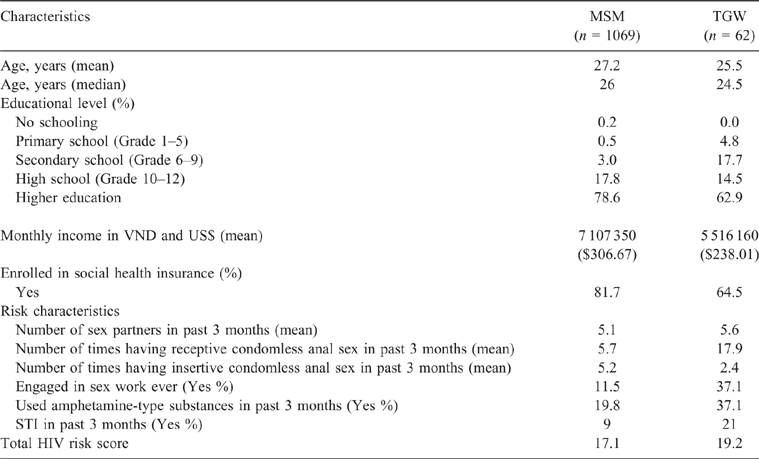
|
In terms of HIV-related risk factors as baseline, TGW overall were at greater risk than MSM with a higher average number of condomless anal receptive sex events in the past 3 months (17.9) than among MSM (5.7); amphetamine-type substances use in the past 6 months (37.1% among TGW vs 19.8% for MSM); having ever engaged in sex work (37.1% for TGW vs 11.5% for MSM); and self-reported STI (21% for TGW vs 9% for MSM). Overall, HIV risk scores were also higher among TGW than MSM (19.2 vs 17.1, respectively).
PrEP uptake and rate of enrolment in P4P
PrEP enrolment increased over time from an average of 27 MSM per month in the first 3 months (March–June 2017) to 134 per month in the last 3 months (March–June 2018). However, among TGW, PrEP enrolment was very slow and did not improve significantly over time (Fig. 4).
eGFR values over time
In addition to the three MSM that had abnormal eGFR test values (<60 mL min–1 1.73 m–2) at baseline, two additional MSM presented with abnormal eGFR values (M6, age 26 years and M12, age 27 years), which required discontinuation of PrEP.
PrEP continuation rates and survival analysis
By M3, PrEP survival analysis for PrEP continuation indicated that 88.7% of MSM and 87.1% of TGW continued on PrEP. By M12, 68.8% of MSM and 54.8% of TGW continued on PrEP, and by M18, continuation plateaued to 52.8% for TGW but declined further to 46.6% for MSM (Fig. 5).
PrEP discontinuation and reasons for discontinuation
There was a total of 387 drop-outs, of which 191 MSM and 18 TGW responded to a follow-up online survey. Among MSM and TGW, 16.7% and 15.2% respectively stopped PrEP because they perceived themselves to no longer be at risk of HIV. Other primary reasons for PrEP discontinuation among MSM were not having enough money to pay for PrEP (22.5%), shame of being seen using PrEP (16.7%), and worry about health problems associated with long-term use of PrEP (15.2%). For TGW, not having enough money to pay for PrEP (33.3%) and sexual partner recommending discontinuing PrEP (27.8%) were the main reasons for stopping. Among all MSM and TGW that dropped out of PrEP, one MSM reported seroconverting after stopping PrEP (Fig. 6).
Self-reported PrEP adherence and HIV seroconversions
Among MSM, self-reported use of four or more pills in the past week was 91.6% at M3, 91.8% at M6, 92.6% at M9, 95.3% at M12, 97.4% at M15, and 69.8% at M18. For TGW, self-reported adherence of seven pills a week was 70.9% at M3, 68.2% at M6, 87.0% at M9, 84.2.3% at M12, 11.1% at M15, and 88.9% at M18 (Table 3). There were three HIV seroconversions among MSM during the P4P study period, which were all detected in the first month on PrEP. These newly HIV diagnosed individuals were successfully enrolled on ART and virally suppressed.

|
Factors associated with continuing on PrEP among MSM
In the univariable regression analysis, having health insurance, lower than the mean income, having a higher education level, being older than age 30 years, amphetamine type stimulants (ATS) use, engaging in sex work, and having a higher-than-average number of sex partners and condomless receptive anal sex were positively associated with PrEP continuation (P < 0.05). Factors associated with greater odds of continuing on PrEP that remained statistically significant in the adjusted multivariable analysis (Table 4) were: having a lower-than-average income (adjusted odds ratio (aOR) 2.38 (95% confidence interval (CI): 1.59–3.54), P < 0.001); being older than age 30 years (aOR 2.03 (95% CI: 1.30–3.40), P = 0.007); and having an increasing number of sex partners (aOR: 1.06 (1.01–1.11), P = 0.011).
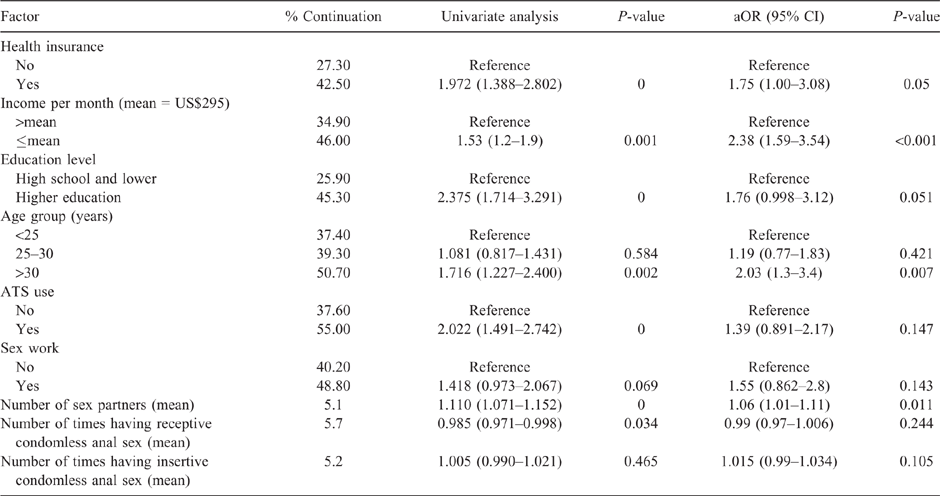
|
Factors associated with continuing on PrEP among TGW
The univariable regression analysis (see Table 5) determined that being older than age 30 years was associated with continuing on PrEP (OR 5.56 (95% CI: 1.23–25.75), P = 0.027), which remained statistically significant in the adjusted multivariable analysis (aOR 5.62 (95% CI: 1.05–29.9), P = 0.043).
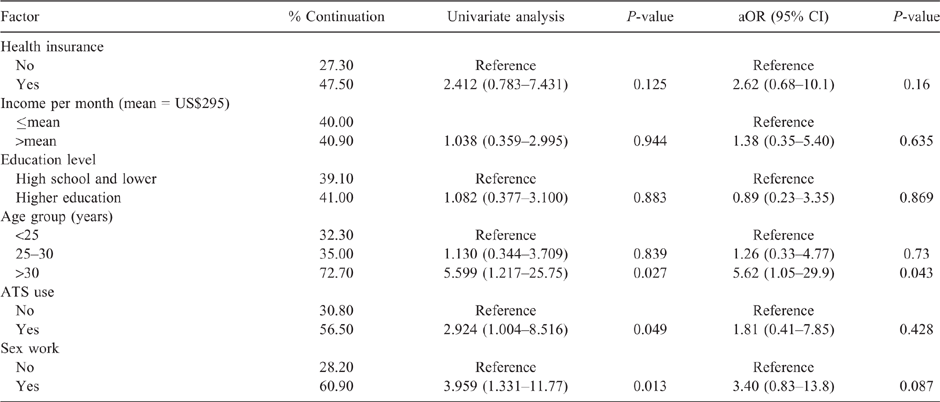
|
Discussion
Pre-exposure prophylaxis was delivered for the first time in Vietnam through the P4P demonstration project and, despite being new, enrolment increased five-fold from the first 3 months (March–June 2017) to last 3 months (March–June 2018) of enrolment. These increases, however, were seen primarily among MSM. PrEP enrolment by TGW was relatively flat over time, suggesting barriers to PrEP access and acceptability among this population need to be further explored and addressed as part of PrEP scale-up in Vietnam.
The PrEP continuation survival analysis indicated that PrEP use declined substantially from enrolment to M9 and then plateaued through to M18 and remained higher among MSM than TGW, except in the last 3 months where continuation dropped to 46.6% among MSM while remaining relatively level at 52.8% for TGW. Among MSM, self-reported adherence to PrEP (four or more times a week) was consistently very high (>90%) over the study period. However, among TGW, self-reported adherence varied significantly, from 11.1% to 88.9%. These variations may have been influenced by the smaller sample size overall and among those who were followed on PrEP for the entire 18 months (n = 9).
The PrEP continuation rates calculated through the survival analyses were higher in comparison with PrEP roll-out in other similar settings. The Princess PrEP program in Thailand reported 46.8% of MSM and 25.3% of TGW remaining on PrEP by M12.27 In the US, data from Gilead Sciences shows an increase in PrEP continuation to M6 over time, growing from 10% at first roll-out to >60% by 2017.28 Pyra et al. posit that this may be due to increased knowledge of PrEP and support for those on PrEP.28 In Vietnam, as part of real-world PrEP implementation in 2020, PrEP continuation in Ministry of Health (MOH) and USAID/PATH Healthy Markets supported by KP-led and public sector clinics (n = 18) across three provinces was 81% at M6 and 71% at M12. KP-led clinics represented a higher continuation rate (91% at M6 and 83% at M12) than the public sector clinics (59% at M6 and 45% at M12).22 This suggests that PrEP continuation rates have improved over time from the P4P pilot in 2017 to now, perhaps representing a similar phenomenon to what has been observed in the US. The reasons for this need to be further explored, but potentially relate to the type of clinic (KP-led vs public sector), as well as an increase in normalisation and knowledge of PrEP among users, and improved capacity of providers.
As part of P4P, we found that age was significantly associated with PrEP continuation, with those older than age 30 years more likely to stay in care. Other studies in Asia among MSM and TGW have identified younger age as a primary factor associated with increased probability of discontinuing PrEP use.27,29 This suggests that further understanding of barriers to PrEP continuation among younger MSM and TGW is needed to ensure that services work for them.
Among the MSM and TGW participating in P4P, there were three MSM with abnormal eGFR that were unable to enrol in PrEP services and an additional two MSM who were measured with abnormal eGFR and who were required to discontinue PrEP. This represents a 0.19% occurrence in MSM enrolled in P4P, whereas eGFR was measured as normal among TGW. Our findings were similar to those reported by the Princess PrEP Program.27
There are several limitations associated with the data presented in this paper. This was a pragmatic demonstration project which applied rolling study enrolment throughout the study period; we therefore, were not able to follow the entire enrolled sample over an 18-month period. As the model was partially fee-based, only MSM and TGW who could afford the monthly price of the PrEP antiretrovirals were able to participate. As such, the results presented only reflect those of a subset of MSM and TGW who had the means to pay US$0.50 cents a day for PrEP. Although cost of PrEP was reported as a limiting factor for only three MSM at enrolment, 22.5% of MSM and 33.3% of TGW who dropped out of PrEP said they did so because of cost. We also found higher income was associated with PrEP continuation, suggesting that the cost of PrEP affected continuation. This underscores the importance of making available a range of PrEP models following a total market approach, ranging from free, to partially subsidised to fully commercial to optimise access, equity and choice.
In addition, the sample size among TGW was small (n = 62), which resulted in limitations when running multivariable regressions and led to wide confidence intervals. Lack of free STI testing was another limitation. We were not able to measure the true degree of asymptomatic STIs at baseline and through follow up. Finally, self-reported adherence is a subjective measure and may not align with actual behaviour. However, we only identified three HIV seroconversions among those on PrEP, which were missed AHIs found at M1 re-testing for HIV.
Despite these limitations, this study provided very first results related to PrEP implementation in Vietnam and the acceptability of PrEP among MSM and TGW. Key findings from P4P informed national discourse related to service delivery design and scale-up. Importantly, PrEP was encoded in national guidelines by December 2017, 9 months into P4P service delivery and incrementally scaled-up in subsequent years.30 P4P provided a blueprint for a collaborative service delivery model between KP-led CBOs, private and public clinics and local and national HIV program leaders. By end of September 2020, there were 10 097 people on PrEP and 13 265 people who used PrEP at least once in the past 12 months, and 111 clinics offering free PrEP services across 27 provinces.31,32 Vietnam is now among three countries in Asia–Pacific with more than 10 000 people cumulatively using PrEP and with a national PrEP program in place (https://data.prepwatch.org/).
To guide PrEP scale-up for impact, the MOH has developed an exciting plan with ambitious targets for increasing PrEP uptake over the next 5 years.33 The plan describes the need for innovation and creativity in PrEP service delivery to ensure there are a range of models in place that differentiate, simplify and further de-medicalise how PrEP services are offered. Many of the differentiated service delivery strategies defined in the national scale-up plan (such as telehealth, delivery of PrEP medicines and home laboratory sample collection) were temporarily applied during COVID-19 outbreaks, so there is already a foundation from which to build. The plan also calls for considerations in how to finance PrEP before external donor support declines so service delivery and coverage can be sustained.
Conclusions
Through the P4P demonstration project, we found PrEP to be highly acceptable among MSM. Additional effort is needed to tailor PrEP services to the needs of TGW. Continuation rates were relatively high for the first roll-out of PrEP; however, MSM and TGW aged ≤30 years were more likely to discontinue services. Ensuring there is choice in service models, and further differentiating and adapting PrEP delivery among MSM and TGW seeking PrEP, will be essential as part of PrEP scale-up, and in enabling Vietnam to achieve its goal of ending AIDS by 2030.
Conflicts of interest
KEG is a guest editor of Sexual Health but was blinded from the peer-review process for this paper. The remaining authors declare that they have no conflicts of interest.
Acknowledgements
The authors would like to acknowledge the significant contributions of the owners and staff of three key population-led and owned clinics in Ho Chi Minh City (Glink Clinic, Galant Clinic, and My Home Clinic) and the community-based organisations that partner with them (Glink, G3VN, Aloboy, M4M, Colour of Life, Smile, Vuot Song, Real Life, and The Boy); Life Center; Ho Chi Minh City Provincial AIDS Center; and District Health Centers of districts 1, 8, 11, and Thu Duc that pioneered PrEP introduction in Vietnam. We thank USAID for their support and funds for the Prepped for PrEP pilot. Finally, a thank you to Elaine Ung and Zoe Humeau for their edits to the manuscript. Finally, we thank USAID for funding this pilot as part of the USAID/PATH Healthy Markets project.
References
[1] World Health Organization. Guidance on oral pre-exposure prophylaxis for serodiscordant couples, men and transgender women who have sex with men at high risk of HIV: recommendations for use in the context of demonstration projects. 2012. Available online at: https://apps.who.int/iris/bitstream/handle/10665/75188/9789241503884_eng.pdf;jsessionid=75B126F97A9C17C382B786AEA4D68FF7?sequence=1 [verified 27 December 2020].[2] World Health Organization (WHO). Consolidated HIV prevention and treatment guidelines. Geneva: WHO; 2015.
[3] San Francisco Department of Public Health. HIV epidemiology annual report 2018. 2019. Available online at: https://www.sfdph.org/dph/comupg/oprograms/HIVepiSec/HIVepiSecReports.asp [verified 15 September 2020].
[4] Grulich AE, Guy R, Amin J, Jin F, Selvey C, Holden J, et al Population-level effectiveness of rapid, targeted, high-coverage roll-out of HIV pre-exposure prophylaxis in men who have sex with men: the EPIC-NSW prospective cohort study. Lancet HIV 2018; 5 e629–37.
| Population-level effectiveness of rapid, targeted, high-coverage roll-out of HIV pre-exposure prophylaxis in men who have sex with men: the EPIC-NSW prospective cohort study.Crossref | GoogleScholarGoogle Scholar | 30343026PubMed |
[5] Koss CA, Havlir DV, Ayieko J, Kwarisiima D, Kabami J, Atukunda M, et al. OAC0805: lower than expected HIV incidence among men and women at elevated HIV risk in a population-based PrEP study in rural Kenya and Uganda: interim results from the SEARCH study. 23rd International AIDS Conference; 6–10 July 2020. Available online at: https://onlinelibrary.wiley.com/doi/full/10.1002/jia2.25547 [verified 27 December 2020].
[6] Vietnam Ministry of Health (MOH). HIV sentinel surveillance reports. Hanoi: MOH; 2011.
[7] Vietnam Ministry of Health (MOH). HIV sentinel surveillance reports. Hanoi: MOH; 2013.
[8] Vietnam Ministry of Health (MOH). HIV sentinel surveillance reports. Hanoi: MOH; 2015.
[9] Vietnam Ministry of Health (MOH). HIV sentinel surveillance reports. Hanoi: MOH; 2016.
[10] Vietnam Ministry of Health (MOH). HIV sentinel surveillance reports. Hanoi: MOH; 2017.
[11] Ministry of Health (MOH), National Institute of Hygiene and Epidemiology. HIV/STI integrated biological and behavioral surveillance (IBBS) in Vietnam: results from round III 2013 and trends across three rounds (2005–2009–2013) of surveys. 2014. Available online at: https://www.researchgate.net/publication/305471855_HIVSTI_Integrated_Biologcial_and_Behavioral_Surveillance_IBBS_in_Vietnam_-_Results_from_Round_III_and_Trends_Across_Three_Rounds_2005_-_2009_-_2013_of_Surveys [verified 5 September 2020].
[12] Vietnam Ministry of Health (MOH). HIV sentinel surveillance reports. Hanoi: MOH; 2018.
[13] Colby D, Nguyen NA, Le L, Toan T, Thien DD, Huyen HT, et al HIV and syphilis prevalence among transgender women in Ho Chi Minh City, Vietnam. AIDS Behav 2016; 20 379–85.
| HIV and syphilis prevalence among transgender women in Ho Chi Minh City, Vietnam.Crossref | GoogleScholarGoogle Scholar | 27435074PubMed |
[14] Pham QD, Wilson DP, Kerr CC, Shattock AJ, Do HM, Duong AT, et al Estimating the cost-effectiveness of HIV prevention programmes in Vietnam, 2006–2010: a modelling study. PLoS One 2015; 10 e0133171
| Estimating the cost-effectiveness of HIV prevention programmes in Vietnam, 2006–2010: a modelling study.Crossref | GoogleScholarGoogle Scholar | 26196290PubMed |
[15] Vu BN, Green K, Phan HT, Tran MH, Vo SH, Ngo HV, et al. Lay provider HIV testing: a promising strategy to accelerate 90–90–90 in Vietnam. MOPED1105. Presented at the 9th IAS Conference on HIV Science; 23–26 July 2017; Paris, France. Geneva: International AIDS Society (IAS); 2017.
[16] Green K, Vu BN, Phan HT, Tran MH, Vo SH, Ngo HV, et al. How acceptable and feasible is HIV self-testing among key populations in Vietnam? Preliminary results from an intervention evaluation study. TUPEC0844. Presented at the 9th IAS Conference on HIV Science; 23–26 July 2017; Paris, France. Geneva: International AIDS Society (IAS); 2017.
[17] Green KE, Vu BN, Phan HT, Tran MH, Ngo HV, Vo SH, et al From conventional to disruptive: upturning the HIV testing status quo among men who have sex with men in Vietnam. J Int AIDS Soc 2018; 21 e25127
| From conventional to disruptive: upturning the HIV testing status quo among men who have sex with men in Vietnam.Crossref | GoogleScholarGoogle Scholar | 30033557PubMed |
[18] Oldenburg CE, Biello KB, Colby D, Closson EF, Nguyen T, Trang NN, et al Engagement with peer health educators is associated with willingness to use pre-exposure prophylaxis among male sex workers in Ho Chi Minh City, Vietnam. AIDS Patient Care STDS 2014; 28 109–12.
| Engagement with peer health educators is associated with willingness to use pre-exposure prophylaxis among male sex workers in Ho Chi Minh City, Vietnam.Crossref | GoogleScholarGoogle Scholar | 24601733PubMed |
[19] Oldenburg CE, Le B, Toan T, Thien DD, Huyen HT, Friedman MR, et al HIV pre-exposure prophylaxis indication and readiness among HIV-uninfected transgender women in Ho Chi Minh City, Vietnam. AIDS Behav 2016; 20 365–70.
| HIV pre-exposure prophylaxis indication and readiness among HIV-uninfected transgender women in Ho Chi Minh City, Vietnam.Crossref | GoogleScholarGoogle Scholar | 27435073PubMed |
[20] Oldenburg CE, Le B, Huyen HT, Thien DD, Quan NH, Biello KB, et al Antiretroviral pre-exposure prophylaxis preferences among men who have sex with men in Vietnam: results from a nationwide cross-sectional survey. Sex Health 2016; 13 465–473.
| Antiretroviral pre-exposure prophylaxis preferences among men who have sex with men in Vietnam: results from a nationwide cross-sectional survey.Crossref | GoogleScholarGoogle Scholar |
[21] Green K. Prepped 4 PrEP! KP-led services in Vietnam. Paper presented at the 2nd Asia-Pacific Regional Consultation on PrEP Implementation; 16 Jan 2018; Bangkok, Thailand. 2018. Available online at: https://www.prevention‐trcarc.org/files/10.Kimberly%20Green‐%20Prepped%204%20PrEP!pdf [verified 5 March 2020].
[22] Vu BN, Le TM, Le S, Nguyen PA, Vu HB, Nguyen DAD, et al. Leading from the community: how key population organizations in Vietnam transformed from peer support groups to clinical service providers. Abstract presented at the 23rd IAS Conference (AIDS 2020); 6–10 July 2020; San Francisco, CA, USA. 2020. Available online at: http://www.differentiatedcare.org/Portals/0/adam/Content/xJSbv2c4Aka9DfjRMTOEHg/File/bao_vu_slides_vietnam_KP.pdf [verified 5 September 2020].
[23] Green K, Vu NB, Nguyen Thi PH, Do NT, Tran MH, Le TM, et al. Key population-delivered oral pre-exposure prophylaxis: initial enrollment, adherence and retention results among men who have sex with men in Vietnam. TUPEC409. Presented at the 10th IAS Conference on HIV Science; 21–24 July 2019; Mexico City, Mexico. 2019. Available online at: http://programme.ias2019.org/Abstract/Abstract/2551 [verified 5 September 2020].
[24] Viet Nam News. Oral HIV pre-exposure service launched. Viet Nam News, 14 June 2017. Available online at: http://vietnamnews.vn/society/378216/oral-hiv-pre-exposure-service-launched.html#FeWWmssZjmwhKF6a.97 [verified 14 November 2017].
[25] Colby D, Kongkabpan M, Teeratakulpisarn S, Teeratakulpisarn N, Pondet C, Pakam C, et al. PrEP or peril: rolling out PrEP in the private sector without subsidy or government support. Symposium presentation THSY0206 at XXII International AIDS Conference; 23–27 Jul 2018; Amsterdam, The Netherlands. 2018. Available online at: https://programme.aids2018.org/PAGMaterial/PPT/178_4840/PrEP%20or%20peril-Colby-AIDS18(26.07.18).pptx [verified 10 September 2020].
[26] United States Centers for Disease Control and Prevention (CDC). Preexposure prophylaxis for the prevention of HIV infection in the United States – 2014. Atlanta, GA: CDC; 2014.
[27] Phanuphak N, Sungsing T, Jantarapakde J, Pengnonyang S, Trachunthong D, Mingkwanrungruang P, et al Princess PrEP program: the first key population-led model to deliver pre-exposure prophylaxis to key populations by key populations in Thailand. Sex Health 2018; 15 542–55.
| Princess PrEP program: the first key population-led model to deliver pre-exposure prophylaxis to key populations by key populations in Thailand.Crossref | GoogleScholarGoogle Scholar | 30249317PubMed |
[28] Pyra MN, Haberer JE, Hasen N, Reed J, Mugo NR, Baeten JM. Global implementation of PrEP for HIV prevention: setting expectations for impact. J Int AIDS Soc 2019; 22 e25370
| Global implementation of PrEP for HIV prevention: setting expectations for impact.Crossref | GoogleScholarGoogle Scholar | 31456348PubMed |
[29] Lee SS, Kwan TH, Wong NS, Lee KCK, Chan DPC, Lam TTN, et al Piloting a partially self-financed mode of human immunodeficiency virus pre-exposure prophylaxis delivery for men who have sex with men in Hong Kong. Hong Kong Med J 2019; 25 382–91.
| 31619578PubMed |
[30] Vietnam Ministry of Health (MOH). National HIV care and treatment guidelines. Hanoi: MOH; 2017.
[31] Hai HN. Updated on PrEP implementation in Vietnam. Workshop for 15 Global Fund for AIDS, TB and Malaria funded provinces, 4 September 2020. Hanoi: Vietnam Ministry of Health; 2020.
[32] Long NH, Green K. PrEP scale up and STI management: country perspective: Vietnam. Paper presented at the 10th IAS Conference on HIV Science; 21–24 July 2019; Mexico City, Mexico. 2019. Available online at: http://programme.ias2019.org/Programme/Session/155 [verified 27 December 2020].
[33] Vietnam Ministry of Health (MOH). Five year PrEP scale-up plan, 2021–2025. Hanoi: MOH; 2020.


